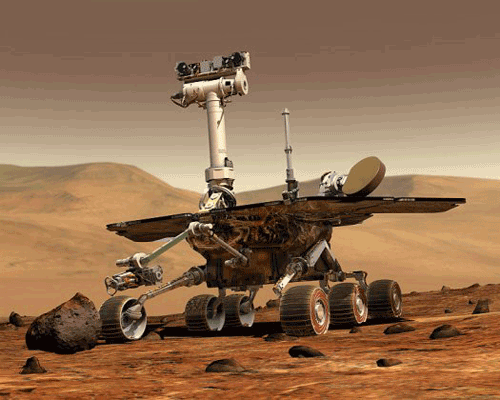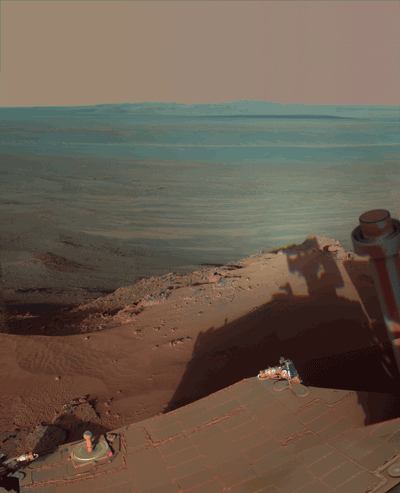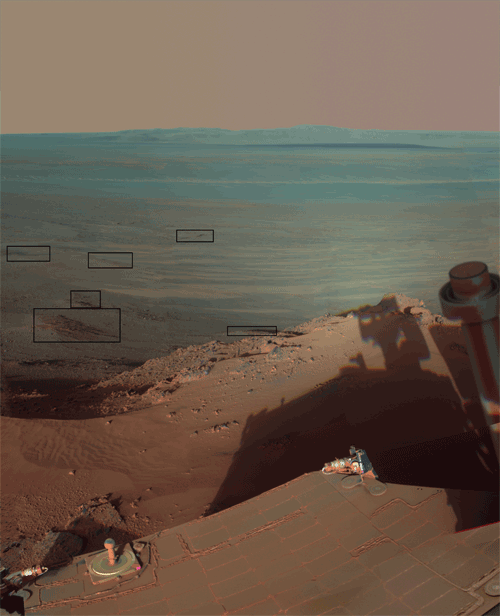Stunning photo from NASA’s Mars exploration rover, Opportunity
Uses low sun angle to create awe-inspiring image of shadow and crater below
Standing before a large Martian crater, NASA’s Mars Exploration Rover “Opportunity” waited for the opportune moment to take a stunning photo of everything before it.

NASA’s Mars Exploration Rover “Opportunity” (Via: popsci.com)
The rover waited for the sun to angle just low enough to cast a shadow of the bot in the foreground, laid out right before the edge of a large impact crater immediately in front of it:

Stunning photo of Mars’s Endeavour Crater, taken by NASA’s “Opportunity” rover. (Via: nasa.gov)
According to Opportunity’s Foursquare check-in (just kidding . . . for now), it is stationed on the western rim of the Endeavour Crater and is looking eastward. In terms of what you’re looking at, the crater measures about 14 miles in diameter; that’s about the same size as the city of Seattle, and 20 times wider than Victoria Crater, the largest impact crater that Opportunity was previously studying.
Now, upon close inspection of the photo, you’ll probably notice that the color’s a bit off; that there’s somewhat of an aqua tint to it. That’s because the photo was generated in false color so as to emphasize the differences in materials on the planet’s surface.
The effects of this are best evidenced with the dark dunes on the crater floor, which are much more noticeable using this trick:

Boxes point out sand dunes made visible using false-color treatment.
Further insight on the photo
The solar-powered rover captured a collection of component images back on March 9 when it was stationed at the Greeley Haven outcrop on the Cape York segment of Endeavour’s western rim: It had to stay there for a few weeks to preserve its energy during the Martian winter (it has actually been around the Endeavour Crater since August 2011).
Opportunity used a panoramic camera between 4:30 and 5:00 p.m. local Mars time to record images using various different filters. Parts of about a dozen photos were collected and pieced together to provide this stunning mosaic view of Mars. Photos selected were focused on wavelengths of 753 nm (near infrared), 535 nm (green), and 432 nm (violet).
Opportunity has since resumed driving around Mars. At present, it is investigating a patch of windblown Martian dust located near the aforementioned Greeley Haven outcrop.
Background
Opportunity has a rover twin called “Spirit.” The duo completed their three-month missions on Mars back in April 2004. After that, both rovers went into bonus-coverage mode, extending their missions for as long as they were still able to function. Their time spent on our neighboring planet has led to important discoveries about a wet environment on ancient Mars, which suggests the possibility that Mars, at one time, was able to support microbial life forms.
Spirit ceased communication in 2010, while Opportunity has continued trucking along. In total, that is, since its initial landing in January 2004, Opportunity has traveled a distance of 21.4 miles across Mars.
NASA’s Jet Propulsion Laboratory, a division of the California Institute of Technology, manages the Mars Exploration Rover Project for NASA’s Science Mission Directorate, Washington. You can learn more about the project at marsrover.nasa.gov ■
Story via: NASA.gov
Advertisement
Learn more about Electronic Products Magazine





